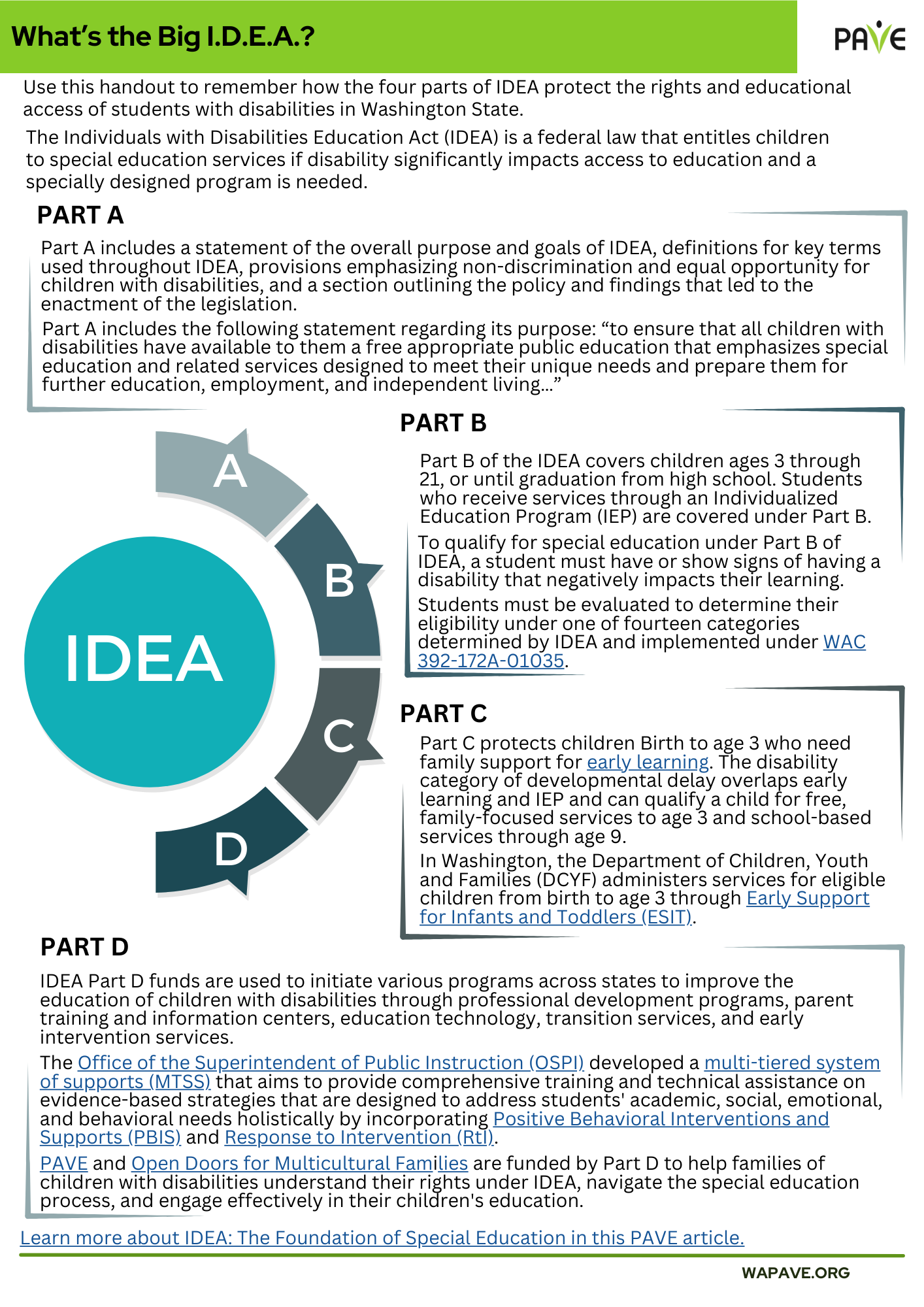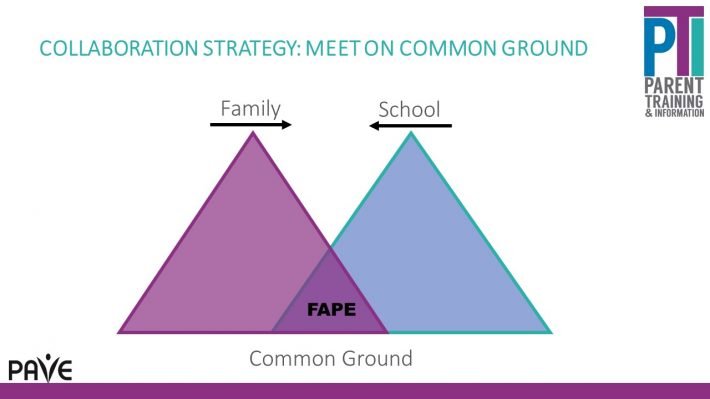A Brief Overview
- School districts have an affirmative duty to locate, evaluate and potentially serve any infant, toddler or school-aged student impacted by disability under the Child Find Mandate — part of special education law.
- The duty to evaluate is based on a known or suspected disability that may significantly impact access to learning. Data from evaluation then determines eligibility. Washington’s Office of Superintendent of Public Instruction (OSPI) has state specific information about Child Find.
- PAVE recommends making referrals in writing and provides a sample letter.
- Public school districts provide evaluations and special education services at no cost to the family.
- Child Find is intact during the pandemic, as are all student rights and protections. For more information, PAVE provides a training video: Student Rights: Special Education During COVID-19 and Beyond.
Full Article
Family caregivers, teachers, or anyone else can refer a child for an educational evaluation if there is reason to suspect that a disability is impacting that child’s ability to learn. The local school district provides a comprehensive evaluation, free to the family, if there is a known or suspected disability and reason to believe that appropriate early learning or school success requires intervention.
The school district’s duty to seek out, evaluate and potentially serve infants, toddlers or school-aged students is guaranteed through the Individuals with Disabilities Act (IDEA), as part of the Child Find Mandate. The law says that this obligation to evaluate exists for all children ages 0-21, regardless of whether they:
- Attend private or public school
- Are housed in a stable way or are homeless
- Live with a birth or adopted family or are a ward of the state
Receiving adequate marks and “passing from grade to grade” does not erase the school’s responsibility to evaluate. Impacts to all areas of school and learning are considered. Academic challenges might trigger an evaluation. So can school refusal, communication deficits, missing social skills, trouble with emotional regulation and behavior challenges.
Children in private and home-based schools are protected by Child Find
Parents have the right to request an evaluation from the public-school district regardless of whether a child attends public school. If the child is found eligible, the local district is responsible to provide services unless the family does not want them. In some cases, families arrange to have a child attend private or home-based school but receive special-education services through the public school. Private schools do not have to evaluate children or provide special education, but they are responsible to provide equitable services and to comply with the Americans with Disabilities Act. See PAVE’s article about navigating private school.
The IDEA includes categories of disability that might qualify a student for special education services at a public school. PAVE has an article about IDEA and additional articles with information about evaluation process.
Request an evaluation in writing
PAVE’s Parent Training and Information (PTI) staff recommend that families request evaluation formally—in writing. Specific deadlines apply in the evaluation process. Washington districts have 25 school days to decide whether to evaluate. After parents sign consent, staff have 35 school days to complete the evaluation.
A sample letter to request evaluation is available on PAVE’s website. The Office of Superintendent of Public Instruction (OSPI) provides more detail about state requirements. A national agency called Wrightslaw has additional information about Child Find.
The Child Find Mandate requires states to implement programs to locate children who might need more support, particularly those who might need services as infants or toddlers. Child Find is written into the IDEA in “Part C,” which protects children 0-3 with known or suspected disabilities in need of early intervention. However, Child Find applies to all children who might need services—through age 21 or until high-school graduation.
Testing determines whether the child has a disability that is causing learning delays. For very young children, this includes a known or suspected disability that might delay learning. For a child younger than 3 in Washington State, early intervention is provided with an Individualized Family Service Plan (IFSP). PAVE’s website includes an article with more information about early intervention services and the transition to school-aged services at age 3.
For a child ages 3-21, an evaluation determines whether a disability is significantly impacting access to school and whether specially designed instruction is necessary for the student to access learning at school.
Schools use data to determine whether a child is eligible for services
The duty to evaluate is based on a known or suspected disability that may significantly impact access to learning. Data from evaluation then determines eligibility. Washington’s Office of Superintendent of Public Instruction (OSPI) has state specific information about Child Find.
The referral process includes a review of existing data about a student. Existing data might include information from families, medical providers and anyone who can discuss a child’s performance at public school, preschool, private school, at home or in another setting. Based on this data, the district decides whether to evaluate. Often the decision is discussed at a “referral meeting” with school staff and parents. If a school district refuses to evaluate, family caregivers can request an explanation in writing and have the right to dispute that decision by exercising Procedural Safeguards.
Child Find requires schools to do outreach
School districts operate Child Find programs in a variety of ways. For example, a school might:
- Train teachers to recognize signs that a student might need to be screened
- Publish, post and distribute information for parents so they can understand how to request evaluation and why a child might benefit from services
- Offer workshops or other trainings to parents about evaluation, early intervention and special education
When should the caregiver for a young child be concerned?
If parents do not think their child is growing or developing like other children the same age, they can request an educational evaluation, even if a pediatrician says there is no cause for concern. The national Center for Parent Information and Resources (CPIR website: ParentCenterHub.org) provides a list of developmental milestones to help parents recognize potential delays.
Early intervention can be critical. Parents can contact their local school district or seek more information and assistance from Early Support for Infants and Toddlers (ESIT), managed by Washington’s Department of Children, Youth, and Families (DCYF).
To determine whether early intervention is needed, an evaluator considers:
- Physical skills (reaching, crawling, walking, drawing, building)
- Cognitive skills (thinking, learning, solving problems)
- Communication skills (talking, listening, understanding others)
- Self-help or adaptive skills (eating, dressing)
- Social or emotional skills (playing, interacting with others)
- Sensory processing skills (handling textures, tastes, sounds, smells)
The evaluator uses natural situations to look at these skills while a child stacks blocks, draws, counts, cuts with scissors, jumps, or performs other activities. Testing time varies, and parents can ask how much time was spent, which settings were reviewed, and who conducted the review.
Parents can decide whether they agree with the results and whether they believe the evaluation was appropriate. “Appropriate evaluation” is protected by special education law, the IDEA, as a primary principle. Parents who disagree with the results of an evaluation—or a school’s decision to not evaluate—have the right to dispute decisions through a variety of informal and formal processes, described in Procedural Safeguards.
Birth-3 services are provided through an IFSP
If an evaluation determines that a child requires early intervention, then those services are provided through an IFSP. Early intervention services might include speech and language therapy; physical therapy; psychological services; home visits; medical, nursing, or nutrition services; hearing or vision services.
In most cases, services are provided in the home or in a child-care setting. The goal is for services to take place in the child’s “natural environment.” Occasionally a child may visit a provider’s office for specialized services.
What does an older child’s evaluation look like?
Educational evaluations for children 3-21 are conducted in consultation with a team that includes parents, teachers, special education professionals and school district administrators and evaluation specialists who can interpret and explain the results.
The assessments can look like academic tests, questionnaires, or informal observations. There are no right or wrong answers, and the evaluators are looking for clues that might show an area of need for different or specialized instruction. A comprehensive evaluation can measure a child’s ability to:
- Think, reason and problem-solve
- Understand spoken language
- Explain ideas and speak clearly
- Understand facial expressions and body language
- Use facial expressions and body language to express emotion
- Remember what they hear and understand different sounds
- See differences in pictures and designs, remember what they see, and understand those visual images
- Use body parts with physical skill
- Get along with other people
- Read, write, spell, and do math
- Hear and see
Parents can provide a health history and notes and diagnoses from medical providers that contribute outside information to be considered as part of the assessment.
The Down Syndrome Guild of Greater Kansas City provides a comprehensive list of commonly used assessments for a variety of disability conditions.
Help for children 3-5 years old
Children ages 3-5 with identified disabilities can receive free special education and related services at preschools run by the local public-school district or through federal Head Start or the state-run Early Childhood Education and Assistance Program (ECEAP). Often these preschools are specifically designed for children with disabilities, so inclusion with general education students may be limited.
Once a student enters the local public school for kindergarten, specialized instruction may be provided in general education by special educators who “push in” with support in the classroom. The IDEA requires education in the Least Restrictive Environment (LRE) to the greatest extent possible with typically developing peers. Special education is a service, not a place: See PAVE’s article with that slogan as its title.
Some children do not thrive in typical classrooms. The IEP team, including the parent, may determine that a smaller classroom or “pull out” instruction is needed for the student to make meaningful progress. These decisions are documented in the IEP.
Related services can support parent training
“Related services” might include speech-language therapy, occupational therapy, mental health counseling or special transportation to school or extracurricular activities. Training about positive behavior interventions for family caregivers, school staff and children also could be provided as a related service. Students who are enrolled in a private or home school may be dually enrolled in public school to access related services provided through an IEP.
During the pandemic, some extra attention has been paid to parent training as a related service in order for parents to understand how to support children learning from home.
What happens if a doctor or teacher refers a child for evaluation?
Any adult knowledgeable about a child’s condition can refer that child for evaluation. If a person outside the family makes the referral, parents get a formal written notification about the referral. Parents must sign consent for an evaluation process to begin.
Parents/guardians do not have to give permission. Parents who refuse to give permission have the right to request an evaluation later.
If school staff refer a student for an evaluation and parents do not want their child evaluated, the school district may ask parents to participate in mediation to further discuss the decision. If parents still refuse to sign consent, a school district can begin a legal procedure called Due Process to have the case considered by an administrative law judge. Through this process, a district may be allowed to screen a child for special education without parent consent.
If a student does not qualify for IEP services, a Section 504 Plan might help
A student who is evaluated and determined ineligible for special education might still qualify for some support with a Section 504 Plan. Section 504 defines disability much more broadly than the IDEA, and a student can qualify for support if an identified disability significantly impacts a major life activity, such as learning or socializing with peers.
Educational evaluations identify barriers to education, so schools can figure out how to help children make meaningful progress. Sometimes special education is provided to help with access to academic learning, and sometimes it is needed for a child to build functional skills or to develop more skill in Social Emotional Learning. When requesting a full and complete evaluation, parents can ask questions and provide feedback to make sure the school evaluates in all areas of suspected disability and that the tools for evaluation are comprehensive and varied.
Sometimes a child comes to the attention of the school because of unexpected behaviors that might lead to disciplinary actions. PAVE’s article, What Parents Need to Know when Behavior Impacts Discipline at School, has additional information for families who might be requesting an educational evaluation because of behavior incidents.



